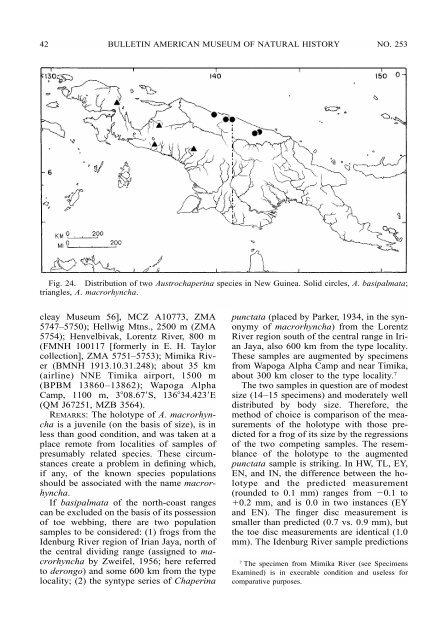SPHENOPHRYNE - American Museum of Natural History
SPHENOPHRYNE - American Museum of Natural History
SPHENOPHRYNE - American Museum of Natural History
You also want an ePaper? Increase the reach of your titles
YUMPU automatically turns print PDFs into web optimized ePapers that Google loves.
42 BULLETIN AMERICAN MUSEUM OF NATURAL HISTORY NO. 253<br />
Fig. 24. Distribution <strong>of</strong> two Austrochaperina species in New Guinea. Solid circles, A. basipalmata;<br />
triangles, A. macrorhyncha.<br />
cleay <strong>Museum</strong> 56], MCZ A10773, ZMA<br />
5747–5750); Hellwig Mtns., 2500 m (ZMA<br />
5754); Henvelbivak, Lorentz River, 800 m<br />
(FMNH 100117 [formerly in E. H. Taylor<br />
collection], ZMA 5751–5753); Mimika River<br />
(BMNH 1913.10.31.248); about 35 km<br />
(airline) NNE Timika airport, 1500 m<br />
(BPBM 13860–13862); Wapoga Alpha<br />
Camp, 1100 m, 308.67S, 13634.423E<br />
(QM J67251, MZB 3564).<br />
REMARKS: The holotype <strong>of</strong> A. macrorhyncha<br />
is a juvenile (on the basis <strong>of</strong> size), is in<br />
less than good condition, and was taken at a<br />
place remote from localities <strong>of</strong> samples <strong>of</strong><br />
presumably related species. These circumstances<br />
create a problem in defining which,<br />
if any, <strong>of</strong> the known species populations<br />
should be associated with the name macrorhyncha.<br />
If basipalmata <strong>of</strong> the north-coast ranges<br />
can be excluded on the basis <strong>of</strong> its possession<br />
<strong>of</strong> toe webbing, there are two population<br />
samples to be considered: (1) frogs from the<br />
Idenburg River region <strong>of</strong> Irian Jaya, north <strong>of</strong><br />
the central dividing range (assigned to macrorhyncha<br />
by Zweifel, 1956; here referred<br />
to derongo) and some 600 km from the type<br />
locality; (2) the syntype series <strong>of</strong> Chaperina<br />
punctata (placed by Parker, 1934, in the synonymy<br />
<strong>of</strong> macrorhyncha) from the Lorentz<br />
River region south <strong>of</strong> the central range in Irian<br />
Jaya, also 600 km from the type locality.<br />
These samples are augmented by specimens<br />
from Wapoga Alpha Camp and near Timika,<br />
about 300 km closer to the type locality. 7<br />
The two samples in question are <strong>of</strong> modest<br />
size (14–15 specimens) and moderately well<br />
distributed by body size. Therefore, the<br />
method <strong>of</strong> choice is comparison <strong>of</strong> the measurements<br />
<strong>of</strong> the holotype with those predicted<br />
for a frog <strong>of</strong> its size by the regressions<br />
<strong>of</strong> the two competing samples. The resemblance<br />
<strong>of</strong> the holotype to the augmented<br />
punctata sample is striking. In HW, TL, EY,<br />
EN, and IN, the difference between the holotype<br />
and the predicted measurement<br />
(rounded to 0.1 mm) ranges from 0.1 to<br />
0.2 mm, and is 0.0 in two instances (EY<br />
and EN). The finger disc measurement is<br />
smaller than predicted (0.7 vs. 0.9 mm), but<br />
the toe disc measurements are identical (1.0<br />
mm). The Idenburg River sample predictions<br />
7 The specimen from Mimika River (see Specimens<br />
Examined) is in execrable condition and useless for<br />
comparative purposes.
















